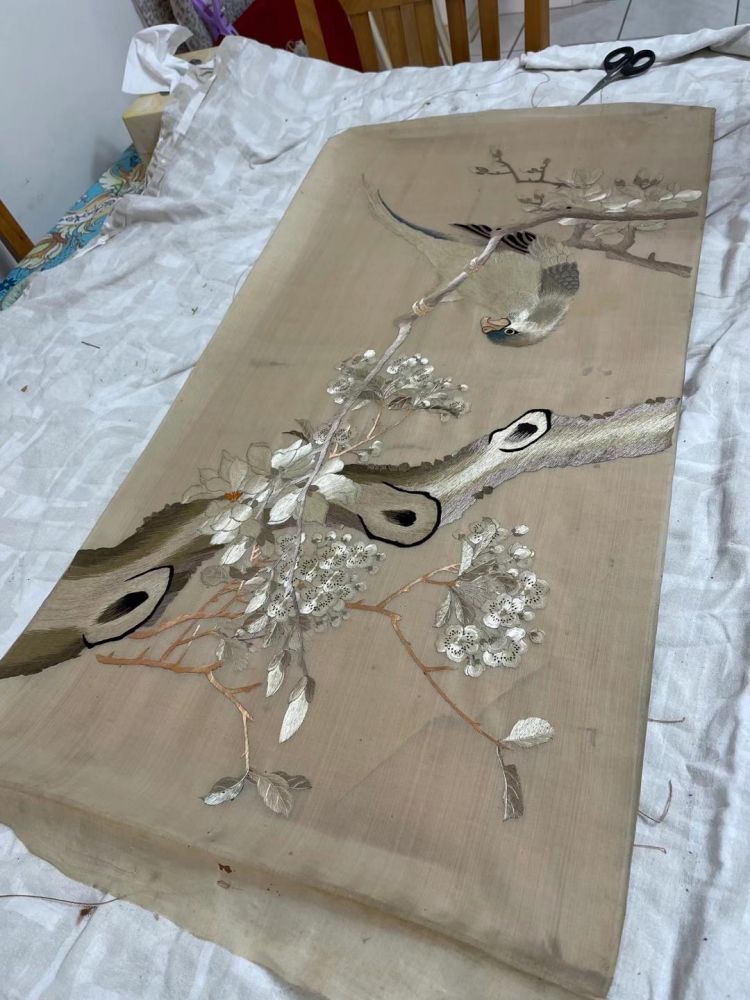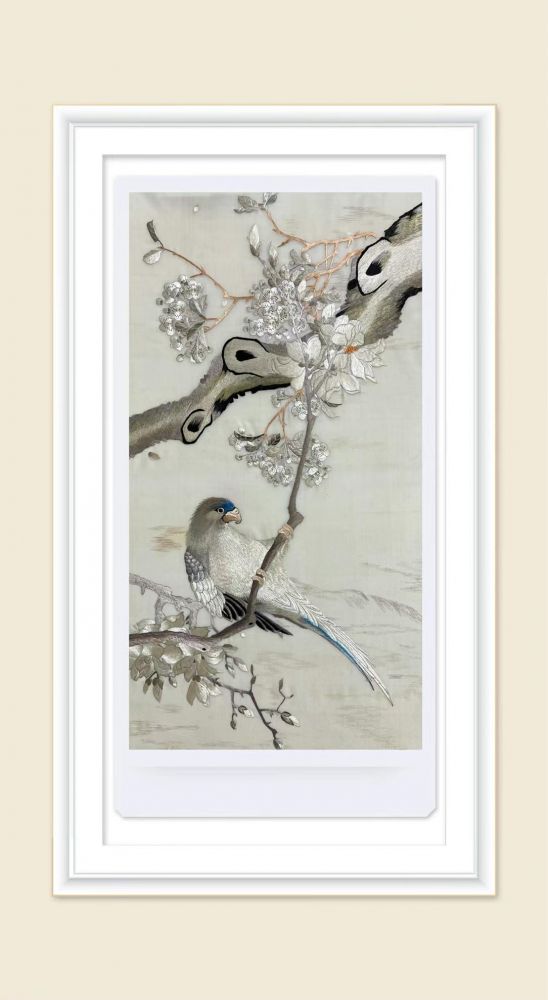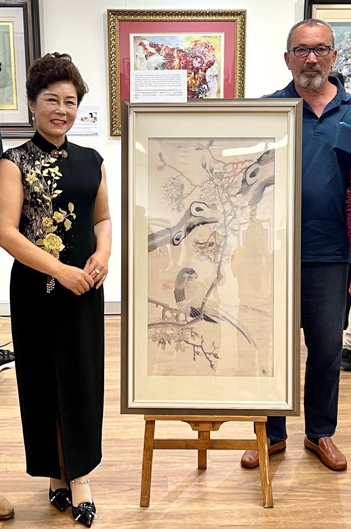鬼谷雄风
有所思,有所感,从历史的时空中来,再回到历史的时空中去。一幅顾绣绣品的来历
这幅鸟儿与梅花的绣品,是有百年历史的顾绣绣品。是Joe Wilkie(魏超,译名)家族祖传。
1、魏超家族溯源
魏超的曾外祖父是华人,名叫William Kong Bow(光宝,译音,其确切的中文名字可能是Ah Bow Heng[洪亚宝,译音])。1850年大约12岁时作为契约劳工来到澳大利亚,在新南威尔士西南部的沃加沃加(Wagga Wagga)及冈德盖(Gundagai)一带牧场做工。1860年前,他去到兰滨坪(Lambing Flat,后来改叫扬埠[Young]),在这里认识了姓Byrnes的一户爱尔兰移民家庭。1860年,22岁的光宝就在这里跟该家庭时年15岁的长女Margaret Byrnes结婚。婚后,Margaret生育了20个孩子,但只存活6个。1874年,他们的女儿Lucy出生。1888年之前,一位原名Law Goon Ghair(罗君者)来澳洲淘金的广东小伙子来到扬埠,认识了光宝和Margaret一家,把名字的英文改成了William Gon Chee(注释1)。当光宝和Margaret在1888年至1889年间决定全家向北迁移,以寻找更好的生活时,罗君者已经心仪其女儿Lucy,决定一起走。他们最终在1889年来到昆士兰的南达令丘陵区(Southern Darling Downs)南端与新南威尔士交界的基拉尼镇(Killarney)定居下来,购地经营农场。一年后,光宝因喉癌去世,由Margaret带领六个孩子继续经营。罗君者则在这里做木匠。1894年,20岁的Lucy与26岁的罗君者结婚。他们夫妇随之也挨着Lucy父母的农场买下一片土地,同样是经营农场,种植小麦、烟叶、玉米、蔬菜,也有一些牧业。他们共生育了12个孩子(9子3女),全部存活。最小的是女儿,生于1917年,名叫Doris Gon Chee,她就是魏超的母亲。
2、顾绣绣品来历
1916年,罗君者19岁的二子Cecil Gon Chee去到广东探亲,次年5月返澳。那幅鸟儿与梅花的顾绣绣品,就是这个时候由Cecil从中国带回来澳洲,交给两个大妹妹保存。
3、顾绣简介
中国刺绣源远流长,至明清时期形成了苏绣、湘绣、粤绣和蜀绣四大名绣,但脱离生活实用成为独立欣赏工艺的则是顾绣。江苏松江顾名世家发扬宋元绣画技法,以宋元山水花鸟人物书画作品为底稿,运用各种丝线材料入绣画,精妙天成,针法细腻多变,绣工善美;画面绣绘结合,以绣代画,是其最为独特之处;同时,吸收西方浪漫主义突显透视的效果,自成风格,是为顾绣,得以闻名传世。其风格和针法对四大名绣尤其是苏绣有较大影响。但顾绣产品到清末式微,民国初年松江府开设松筠女子职校顾绣班,旨在振兴。Cecil去广东祖家的时间,正好与顾绣的振兴时期相吻合。
4、绣品修复
1952年,Doris在布里斯本嫁给德国裔的Alexander Wilkie,生育一女二子,魏超排行老二。Doris在1962年去世,魏超姐弟受到两个姨妈的大力照顾,并将那幅绣品转交给他保存。因其对该绣品不了解,保管不得法,以致绣面发黄,破损严重。2022年9月,他将其送给位于布里斯本的绣珍阁主人——刺绣大家高青敏,由其处理。高青敏觉得绣品很具绣功,表现力强,清新淡雅,显现的是宋元山水花鸟画的特点,遂花费了约一个月的时间将其破损及发霉之处一一补针加以修复。这幅绣品,绣面是鸟儿与梅花,确实是一幅顾绣绣品。
5、展示与意义
高青敏将这幅绣品修复,使其焕然一新。Joe Wilkie认为,是高青敏的精湛技艺使得这幅绣品重生,应由这位刺绣大家决定其最终归宿;高青敏则认为,没有Joe Wilkie将此具有重要历史价值的绣品拿出来,我们就无法看到这样的精美绣品,她应该属于大家。由此可见,这幅顾绣绣品在展现中澳商品的交流及澳华历史的延续传承与融合上,具有重要的价值和历史意义。
The History of A Gu Embroidery Piece
This bird and plum blossom embroidery is an over hundred years old Gu embroidery piece that has been passed down in the Joe Wilkie family.
1. Tracing the Lineage of the Joe Wilkie Family
Joe wilkie's great-grandfather was a Chinese man named William Kong Bow (his exact Chinese name may be Ah Bow Heng). Around 1850, at about 12 years old, he arrived in Australia as an indentured laborer and worked in the Wagga Wagga and Gundagai areas of southwestern New South Wales. Before 1860, he moved to Lambing Flat (later renamed Young), where he met an Irish immigrant family named Byrnes. In 1860, at the age of 22, Kong Bow married Margaret Byrnes, the 15-year-old eldest daughter of the Byrnes family.
After marriage,Margaret gave birth to 20 children, but only six survived. Their daughter Lucy was born in 1874. Before 1888, a young man from Guangdong named Law Goon Ghair came to Australia to seek his fortune in gold mining. He met Kong Bow and Margaret's family in Young and anglicized his name to William Gon Chee. When Kong Bow family decided to move northward between 1888 and 1889 in search of a better life, Law Goon Ghair had already set his sights on their daughter Lucy and decided to join them. They eventually settled in Killarney, at the southern end of the Southern Darling Downs in Queensland, near the border with New South Wales, in 1889, where they purchased land and operated a farm.
A year later,Kong Bow passed away from throat cancer, leaving Margaret to lead the family farm with their six children. Law Goon Ghair worked as a carpenter in Killarney. In 1894, 20-year-old Lucy married 26-year-old Law Goon Ghair. The couple bought land adjacent to Lucy's parents' farm and also operated a farm, growing wheat, tobacco, corn, vegetables, and engaging in some livestock farming. They had a total of 12 children (9 sons and 3 daughters), all of whom survived. The youngest, a daughter born in 1917, was named Doris Gon Chee, who is Joe Wilkie's mother.
2. Origin of the Gu Embroidery Piece
In 1916, Cecil Gon Chee, the second son of Law Goon Ghair, was 19 years old when he went to Guangdong to visit relatives. He returned to Australia in May of the following year. It was during this time that Cecil brought back the Gu embroidery piece depicting birds and plum blossoms from China to Australia and entrusted it to his two older sisters for safekeeping.
3. Introduction to Gu Embroidery
Chinese embroidery has a long history, and during the Ming and Qing dynasties, four major styles of embroidery emerged: Su embroidery, Xiang embroidery, Yue embroidery, and Shu embroidery. However, Gu embroidery stands out as an independent craft for appreciation, detached from practical use.
The Gu family in Songjiang, Jiangsu province, inherited and developed the embroidery techniques of the Song and Yuan dynasties, using landscape, flowers, birds, figures, and calligraphy works from the Song and Yuan dynasties as templates. They utilized various silk threads to embroider these paintings, creating exquisite and ingenious works with delicate and varied stitching techniques. The combination of embroidery and painting, with embroidery replacing traditional painting, is the most unique feature of Gu embroidery. Simultaneously, it absorbed the perspective effects highlighted by Western romanticism, forming its own style, which became renowned as Gu embroidery. Its style and stitching techniques have had a significant influence on the four major styles of embroidery, especially Su embroidery.
However, Gu embroidery declined by the end of the Qing dynasty. In the early years of the Republic of China, the Songjiang Prefecture established the Gu Embroidery Class at the Songyun Women's Vocational School with the aim of revitalizing this art form. Cecil's visit to his ancestral home in Guangdong coincided with the period of revitalization of Gu embroidery.
4. Embroidery Restoration
In 1952, Doris married Alexander Wilkie, of German descent, in Brisbane, and they had one daughter and two sons, with Joe Wilkie being the second eldest. Doris passed away in 1962, and Joe and his siblings were cared for by their two aunts, who entrusted him with the preservation of a piece of embroidery. Due to his lack of understanding of the embroidery, he was unable to properly care for it, resulting in yellowing and severe damage to the embroidered surface.
In September 2022, Joe Wilkie entrusted the embroidery to the embroidery expert Jenny Gao for restoration. Jenny Gao recognized the exquisite craftsmanship of the embroidery, its strong expressive power, and its fresh and elegant style, reflecting the characteristics of Song and Yuan dynasty landscape, flowers, and bird paintings. He spent approximately a month repairing the damaged and moldy areas, meticulously restoring each one with needlework. This piece of embroidery, depicting birds and plum blossoms, is indeed a Gu embroidery masterpiece.
5. Exhibition and Significance
Jenny Gao's restoration work on this embroidery has revitalized it. Joe Wilkie believes that it is Jenny's superb craftsmanship that has brought this embroidery back to life, and therefore, it should be up to this embroidery expert to decide its final destination. However, Jenny Gao believes that without Joe bringing out this embroidery, which holds significant historical value, we wouldn't have been able to appreciate such exquisite craftsmanship, and therefore, it should belong to everyone.
From this, it can be seen that this Gu embroidery piece holds significant historical value and significance in showcasing the exchange of goods between China and Australia, as well as the continuation, inheritance, and integration of Australian Chinese history.
 2022年10月,绣品送来时的破损情况。
2022年10月,绣品送来时的破损情况。
 2022年12月,修复后的顾绣绣品。
2022年12月,修复后的顾绣绣品。
 2023年5月,在绣珍阁绣品展览开幕式上,高青敏和魏超(Joe Wilkie)修复后的顾绣绣品合影。
2023年5月,在绣珍阁绣品展览开幕式上,高青敏和魏超(Joe Wilkie)修复后的顾绣绣品合影。
————————
注释1:罗君者的这个名字,来源于《僑選中央民意代表飛枝區及布利士彬華僑選民登記名冊》,国史馆,典藏号:033-020102-0074。




